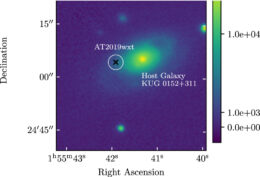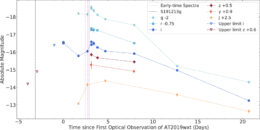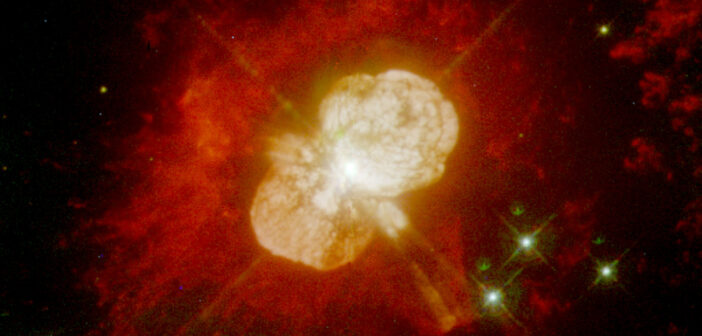What started as the search for the source of a potential gravitational wave signal ended with the discovery of an unusual supernova. The supernova, SN2019wxt, showed a double-peaked light curve similar to previous ultra-stripped supernova candidates.
There and Gone

Location of the newly discovered transient, labeled AT2019wxt, in the outskirts of its host galaxy. [Shivkumar et al. 2023]
“Just” a Supernova
In a recent research article, Hinna Shivkumar (University of Amsterdam) and collaborators outlined the follow-up observations of this intriguing target. As early data trickled in, the object remained hard to classify, though its mostly featureless spectrum with a broad emission line from helium marked it as an exploding star that had lost its outer layers of hydrogen, and it gained the label SN2019wxt.

Optical and near-infrared light curves of SN2019wxt over three weeks following the initial detection. The i and g bands show the intriguing double-peaked shape. Click to enlarge. [SN2019wxt et al. 2023]
Double Peaked and Ultra-stripped?

Bolometric light curve of SN2019wxt (black circles) and best-fitting models of shock cooling (green dashed line) and radioactive decay (blue dashed line). [Shivkumar et al. 2023]
The serendipitous discovery of SN2019wxt makes for a great story, but to learn more about ultra-stripped supernovae in the future, we’ll need to catch them right when they happen. Luckily, the Vera C. Rubin Observatory’s long-awaited Legacy Survey of Space and Time draws ever closer, and after its anticipated start in 2025 will bring one million supernova detections each year — and thus millions of opportunities to study rare supernovae like SN2019wxt.
Citation
“SN2019wxt: An Ultrastripped Supernova Candidate Discovered in the Electromagnetic Follow-up of a Gravitational Wave Trigger,” Hinna Shivkumar et al 2023 ApJ 952 86. doi:10.3847/1538-4357/acd5d5
